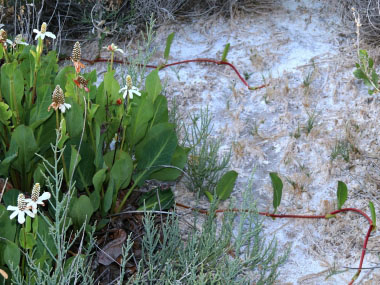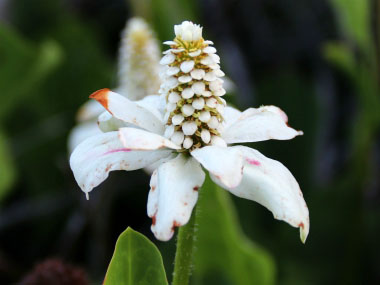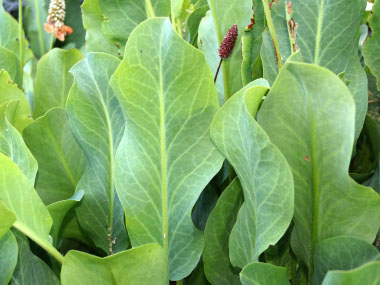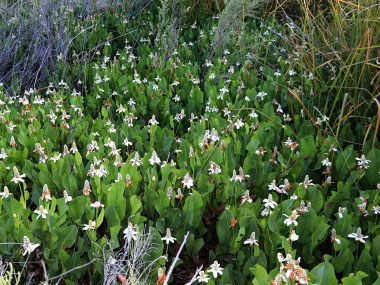





To support our efforts please browse our store (books with health benefits, etc.).
Yerba mansa is a perennial plant that is native to southwestern US and is in the Saururaceae family. Interestingly, yerba mansa means "calming herb" in Spanish (yerba is herb and mansa is calm or tranquil). The true name once was Yerba del Manso. There are many medicinal uses for this plant such as a treatment for abrasions, cuts, burns; helps with gastrointestinal upsets; a poultice for rheumatism and a tonic for blood purification.
Distinguishing Features
This is a beautiful plant that produces unique white flowers in the early spring that remain on the plant until it starts to go dormant in late summer. Due to its creeping rootstocks, it will often spread out like a carpet throughout damper soils choking out any other plants in the area. Once dormant this plant basically disappears from late summer to early winter, then re-sprouts from the roots in late winter. The entire plant takes on red tints in cold snaps and turns brick red in the autumn.
Flowers
In early spring (February to April) numerous tiny white flowers are borne on a cone which is surrounded by 4 to 9 large white spoon-shaped bracts that look like petals. As it matures, the visible part of the plant develops red stains, eventually turning bright red in the fall.
 Fields
of Nutrition has medicinal benefits and vitamin/mineral content of Yerba Mansa.
Fields
of Nutrition has medicinal benefits and vitamin/mineral content of Yerba Mansa.
Leaves
The fleshy, deep green leaves occur as a basal formation. Leaf blades measure 3 to 20 cm (1 to 8”) they are elliptic to oblong, sometimes the base is cordate. The petiole measures 2 to 40 cm (.7 to 16”). Leaves are generally subsessile to clasping.
Height
This plant grows to 30cm (1') tall and 60cm (2') wide.
Habitat
Yerba mansa prefers wet locations, especially in alkaline or saline marshy places below 2000 metres. It prefers full sun to part shade. to According to the USDA, this plant grows in Oregon and California and reaches to as far east as Texas, including Colorado, Kansas and Oklahoma. It also grows in northwestern Mexico.
Edible Parts
Root can be consumed raw or cooked; it has a peppery flavour. Pulverized seeds can be used to make bread or added into other dishes.
Other Name
Lizard Tail.
A heartfelt thank you goes to Jeff Cuneo in California for providing all the images for this plant page. Much appreciated Jeff!
Winter Survival Food Handbook

PDF Plant Magazines
Types of Wild Food
Geographic Zones Seasons
Disclaimer
EdibleWildFood.com is informational in nature. While we strive to be 100% accurate, it is solely up to the reader to ensure proper plant identification. Some wild plants are poisonous or can have serious adverse health effects.
We are not health professionals, medical doctors, nor are we nutritionists. It is up to the reader to verify nutritional information and health benefits with qualified professionals for all edible plants listed in this web site. Please click here for more information.
Why Edible Wild Food?
- Food costs are rising
- Free, wild food is readily abundant
- Wild food adds nutrition to your diet
- Wild food can help treat various medical conditions





